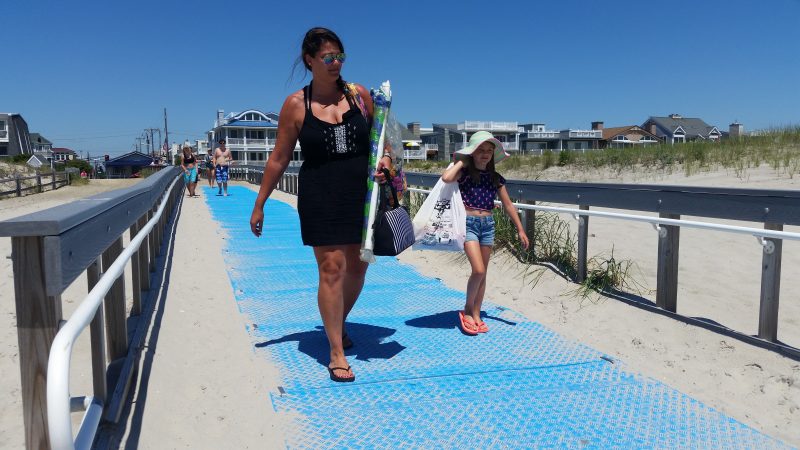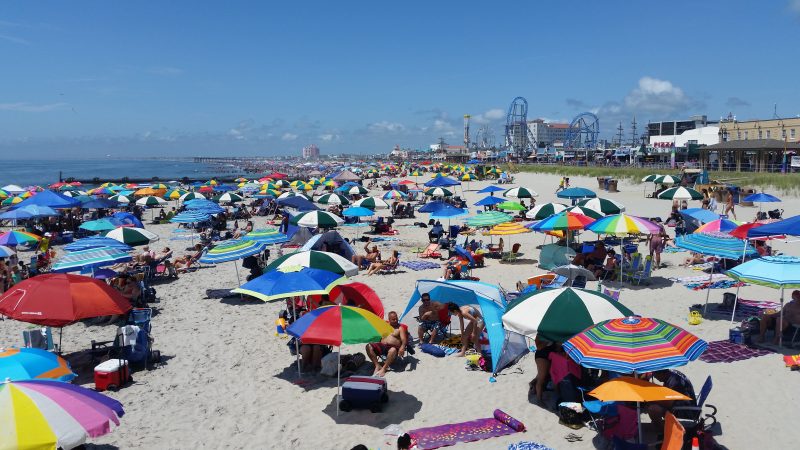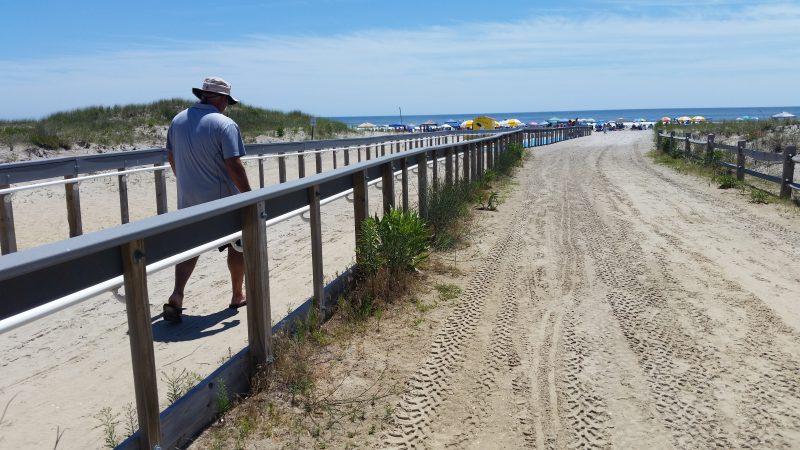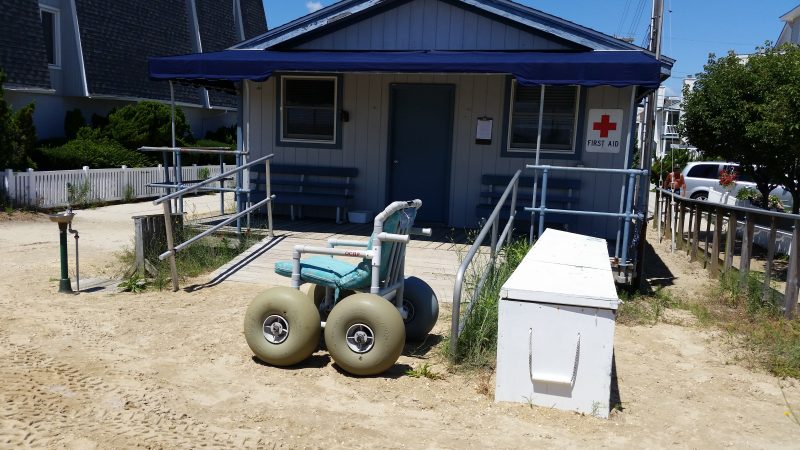Special beach wheelchairs, equipped with big rubber wheels, are available to the public at no cost as part of a city program.
 By Donald Wittkowski
About a week ago, Ocean City resident Mike Daniels made a trip to the 31st Street beach, but he couldn’t get close to the water.
Unable to make it past the dune line, all he could do was to gaze out on the beach. The 71-year-old retired attorney, who has Parkinson’s disease and uses a walker to get around, can’t cross the beach without the help of one of the plastic mobility mats that lie on top of the sand.
“I can’t get to the water. I stop where the mat stops. That’s where the dunes are,” said Daniels, who has lived in Ocean City for 30 years.
The city has placed the so-called mobi-mats at more than 50 beaches throughout town, part of an array of features to improve access to the shoreline. Made of hard plastic, the mats create a footpath that saves beach-goers from the trouble of trudging through thick, powdery sand. Yet they stop short of the water’s edge.
Daniels wants the city to extend at least some of the mobility mats all the way to the high tide line so that senior citizens and disabled people would be able to enjoy the beaches and ocean just the same as everyone else.
Two members of City Council agree. Councilmen Bob Barr and Keith Hartzell are urging the city to create fully handicap-accessible beaches that would include longer mobi-mats providing a path across the sand to the water’s edge.
“There is not one that goes all the way down the beach,” Hartzell said.
Hartzell said the issue was brought to his attention by Daniels, his former attorney. Daniels explained to Hartzell that without the mats, it is impossible for him, while using a walker, to traverse the beach sand.
“It kind of hit me off the top of my head. I’d always assumed we would get one,” Hartzell said of the city having a fully handicap-accessible beach.
By Donald Wittkowski
About a week ago, Ocean City resident Mike Daniels made a trip to the 31st Street beach, but he couldn’t get close to the water.
Unable to make it past the dune line, all he could do was to gaze out on the beach. The 71-year-old retired attorney, who has Parkinson’s disease and uses a walker to get around, can’t cross the beach without the help of one of the plastic mobility mats that lie on top of the sand.
“I can’t get to the water. I stop where the mat stops. That’s where the dunes are,” said Daniels, who has lived in Ocean City for 30 years.
The city has placed the so-called mobi-mats at more than 50 beaches throughout town, part of an array of features to improve access to the shoreline. Made of hard plastic, the mats create a footpath that saves beach-goers from the trouble of trudging through thick, powdery sand. Yet they stop short of the water’s edge.
Daniels wants the city to extend at least some of the mobility mats all the way to the high tide line so that senior citizens and disabled people would be able to enjoy the beaches and ocean just the same as everyone else.
Two members of City Council agree. Councilmen Bob Barr and Keith Hartzell are urging the city to create fully handicap-accessible beaches that would include longer mobi-mats providing a path across the sand to the water’s edge.
“There is not one that goes all the way down the beach,” Hartzell said.
Hartzell said the issue was brought to his attention by Daniels, his former attorney. Daniels explained to Hartzell that without the mats, it is impossible for him, while using a walker, to traverse the beach sand.
“It kind of hit me off the top of my head. I’d always assumed we would get one,” Hartzell said of the city having a fully handicap-accessible beach.
 Ocean City is looking at ways to make its beaches more accessible to people with disabilities or limited mobility.
At the July 12 Council meeting, Hartzell called for the creation of one handicap-accessible beach in each of the city’s four wards. He noted that the city already has four beaches designated for surfing – one in each ward.
“We have four surfing ones. Why not have four handicap-accessible ones?” Hartzell asked during the meeting.
Barr, who was born with cerebral palsy and uses a wheelchair, agreed with Hartzell that the city should explore having handicap-accessible beaches that would include mobi-mats stretching all the way to the high tide line.
Barr believes Ocean City should look at what Brigantine has done to accommodate beach-goers who have disabilities or use wheelchairs.
This summer, Brigantine installed a 350-foot-long, 5-foot-wide mobi-mat at the 16th Street beach entrance that stretches to the high tide line, making it possible for people in wheelchairs to get close to the ocean.
“If you really want to look, that’s a good start,” Barr said of Ocean City using Brigantine’s 16th Street beach as a model.
Ocean City is looking at ways to make its beaches more accessible to people with disabilities or limited mobility.
At the July 12 Council meeting, Hartzell called for the creation of one handicap-accessible beach in each of the city’s four wards. He noted that the city already has four beaches designated for surfing – one in each ward.
“We have four surfing ones. Why not have four handicap-accessible ones?” Hartzell asked during the meeting.
Barr, who was born with cerebral palsy and uses a wheelchair, agreed with Hartzell that the city should explore having handicap-accessible beaches that would include mobi-mats stretching all the way to the high tide line.
Barr believes Ocean City should look at what Brigantine has done to accommodate beach-goers who have disabilities or use wheelchairs.
This summer, Brigantine installed a 350-foot-long, 5-foot-wide mobi-mat at the 16th Street beach entrance that stretches to the high tide line, making it possible for people in wheelchairs to get close to the ocean.
“If you really want to look, that’s a good start,” Barr said of Ocean City using Brigantine’s 16th Street beach as a model.
 Beach mats, like this one at 34th Street, save people from the trouble of trudging through thick sand.
Ocean City spokesman Doug Bergen said the town has made it a priority of having streets, sidewalks, the beaches, bay and Boardwalk accessible to those with disabilities or limited mobility.
Bergen noted that the city intends to look at what Brigantine has done as a possible guide for its beaches.
“The city is always looking for new ways to improve and plans to check out Brigantine’s extended mobi-mat,” Bergen said in a statement. “There would be some challenges to implementation – including a plan for removing or protecting the mats in storms and extreme tides (if they were to go to the high tide line), keeping them from being covered by soft sand, performing daily beach cleaning operations around them, and finding a way for people to enjoy the beach once they reach the end of the path.”
Keeping the mats clean of sand would be especially important for people using electric wheelchairs. Barr pointed out that the sand could damage the wheelchairs.
“Public Works would really need to be on top of it,” Barr said of city work crews clearing away the sand from mats.
Beach mats, like this one at 34th Street, save people from the trouble of trudging through thick sand.
Ocean City spokesman Doug Bergen said the town has made it a priority of having streets, sidewalks, the beaches, bay and Boardwalk accessible to those with disabilities or limited mobility.
Bergen noted that the city intends to look at what Brigantine has done as a possible guide for its beaches.
“The city is always looking for new ways to improve and plans to check out Brigantine’s extended mobi-mat,” Bergen said in a statement. “There would be some challenges to implementation – including a plan for removing or protecting the mats in storms and extreme tides (if they were to go to the high tide line), keeping them from being covered by soft sand, performing daily beach cleaning operations around them, and finding a way for people to enjoy the beach once they reach the end of the path.”
Keeping the mats clean of sand would be especially important for people using electric wheelchairs. Barr pointed out that the sand could damage the wheelchairs.
“Public Works would really need to be on top of it,” Barr said of city work crews clearing away the sand from mats.
 Handrails and hard-packed sand pathways make it easier to access the 34th Street beach.
The mobi-mats are part of a series of improvements offered by Ocean City – ranging from handrails to special pathways to beach wheelchairs – to give senior citizens and people with disabilities greater access to the shoreline.
Bergen said the city now has hard-packed dune crossovers and plastic mobi-mats at 54 different beaches. The beaches at 34th Street and 59th Street include extended dune crossovers, mobi-mats and handrails.
The city is adding Americans with Disabilities Act-compliant ramps over bulkheads and off the Boardwalk. The ramps are included at all numbered street ends in the areas where the Boardwalk has been reconstructed, Bergen said.
Moreover, the city has long had a surf chair program that provides beach-accessible wheelchairs at no cost. The special wheelchairs, equipped with big rubber wheels, allow people with disabilities to get around on the soft sand, join their families on the beach and to get up to the water’s edge, Bergen said.
In addition, new pavilions that were built as part of the Boardwalk’s reconstruction offer a shaded and accessible way for people to enjoy great ocean views, he said.
Handrails and hard-packed sand pathways make it easier to access the 34th Street beach.
The mobi-mats are part of a series of improvements offered by Ocean City – ranging from handrails to special pathways to beach wheelchairs – to give senior citizens and people with disabilities greater access to the shoreline.
Bergen said the city now has hard-packed dune crossovers and plastic mobi-mats at 54 different beaches. The beaches at 34th Street and 59th Street include extended dune crossovers, mobi-mats and handrails.
The city is adding Americans with Disabilities Act-compliant ramps over bulkheads and off the Boardwalk. The ramps are included at all numbered street ends in the areas where the Boardwalk has been reconstructed, Bergen said.
Moreover, the city has long had a surf chair program that provides beach-accessible wheelchairs at no cost. The special wheelchairs, equipped with big rubber wheels, allow people with disabilities to get around on the soft sand, join their families on the beach and to get up to the water’s edge, Bergen said.
In addition, new pavilions that were built as part of the Boardwalk’s reconstruction offer a shaded and accessible way for people to enjoy great ocean views, he said.
 Special beach wheelchairs, equipped with big rubber wheels, are available to the public at no cost as part of a city program.
Special beach wheelchairs, equipped with big rubber wheels, are available to the public at no cost as part of a city program.